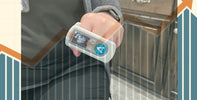-

, by Marko Dombi Athlete-Centric Care: Elevating ACL Rehab with Next-Gen Performance Tools
-

, by Marko Dombi Launch of the EasyBase - Force Plate System For Rehabilitation and Sports
-

, by Marko Dombi Interview with the researcher | Enhanced Paper Grip Test Project
Showing Progress When It Counts
- , by Markus Johnson
- 2 min reading time

This is a series of articles where we invite guests to write about relevant topics in rehabilitation and sports sciences.
Written by Dillon Pittman, COTA/L, OTS / Co-Owner, The Upper Hand LLC
“So, am I getting any better?” If you have spent any amount of time as a therapist or clinician, you have undoubtedly had a client ask you some variation of this question. It’s a fair question: an individual is trusting you to lead in their rehabilitation journey and wants to know if they have made progress.
Often, we as clinicians offer some form of encouragement, either based off our clinical experience, our objective clinical measurements of a client, or both. While a client may be consoled by our clinical opinion and satisfied with an encouraging pat on the back, at least part of this reassurance we provide is strictly based on our clinical opinion. Our own judgement. In this way, it becomes somewhat subjective instead of a true objective answer. Wouldn’t it be great if the clients we serve could actually see evidence of their progress for themselves?
Enter the EasyAngle digital goniometer and EasyForce digital dynamometer by Meloq. These products are providing fresh new ways to obtain the tried-and-true range of motion and strength measurements that we in the therapy field have been obtaining for years. They are an updated, digital version of the tools you likely have in your therapy tool kit or your drawer at the clinic. Utilizing these devices allows a client to see their progress in real time, which can serve as a motivator in their recovery (both in the clinic and at home). In some cases, numeric progress can be seen in a single therapy session, after manual therapy is performed, or even within an exercise itself. It allows patients to compete, as aforementioned, in real time against themselves and their own progress.
It’s no secret that patient motivation is arguably one of the primary drivers behind successful rehabilitation after an injury. So why wouldn’t you want to have a way to equip a patient with the knowledge that they are getting better? Yeah, I can’t think of a solid answer, either. Think about how you could better motivate your clients and facilitate their drive to get in the clinic, get things done, and get back to life.
After all, that’s why we do what we do, right?




